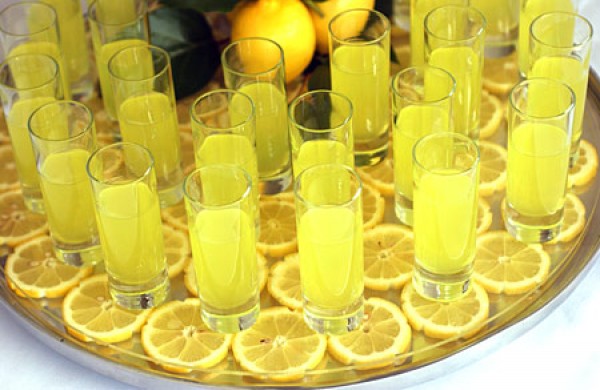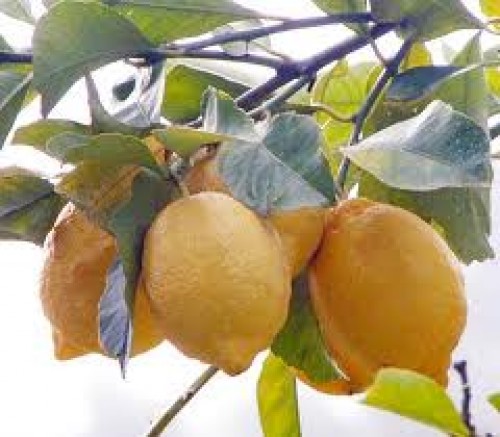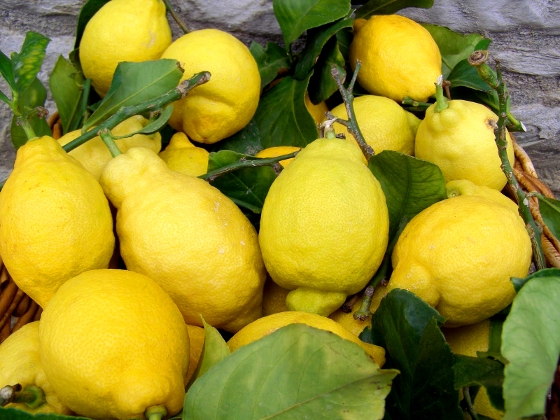Limoncello, la storia e la ricetta

Impossibile sapere il nome del comune mortale a cui Zeus regalò il segreto del limoncello, il più importante dono del signore dell'Olimpo dopo il fuoco. Sicuramente, però, sappiamo dove è successo: nella Terra delle Sirene. Cosa sarebbero queste spiagge e questi scogli senza i limoni? E le tavole senza il limoncello?
Le origini dunque sono misteriose e come sempre accade le ipotesi tante. Due o tre su tutte, tanto per gradire. Alcuni ricordano l'uso dei pescatori contadini di bere un po' di liquore di limone al mattino per combattere il freddo, altri parlano di monaci laboriosi intenti a conservare il bello della vita tra una preghiera e l'altra quando le strade erano insicure e il mare popolato di saraceni predoni.
Sicché oltre ai dolci, le conserve e quant'altro di buono circolava nei secoli bui anche gli infusi più diversi, ottenuti con le fragole, il mirto, il mandarino, la noce di Sorrento, il limone appunto, erano produzione comune nei conventi costruiti tra le rocce e il mare. I monaci certosini cacciarono le Sirene dalla loro terra ma ne conservarono le abitudini più sane, come bere il limoncello.
Sia come sia, nelle case è sempre stata diffusa l'abitudine di conservare nella credenza qualche bottiglia di fragolino, nocillo e limoncello. Quando Capri cominciava a costruire la propria favola moderna all'alba della società di massa, Ignazio e Arturo Cerio, Fersen, Munthe, Krupp e tanti altri sfaccendati ricchi e famosi presero l'abitudine di bere quello fatto da Vincenza Canale che gestiva la pensione Mariantonia.
Qual è il segreto del suo recente successo? Sì, davvero recente. Non dimentichiamo affatto come il fine pasto, anche nella Terra delle Sirene, fosse costituito dalla sambuca o da qualche amaro, poi negli anni '80 la grappa mascalzona capace di allontanare i profumi del mare e oscurare la luce del sole mediterraneo sbaragliò tutti i concorrenti grazie all'idea di distillare monovitigni e trasformare le bottiglie creando piccoli capolavori.
Fu così che il fuoco contadino del Nord conquistò le ambite ed eleganti tavole meridionali.
E dunque, come è nato il successo del limoncello, quale il segreto? Semplice, il frigorifero. Provate a bere un rosso freddo o un bianco a temperatura ambiente, degustateli poi a temperatura di servizio ed ecco come lo stesso vino cambia completamente i profumi e il sapore.
Poco più di dieci anni fa qualcuno, non sappiamo bene chi ma abbiamo fondati sospetti, infila una bottiglia di liquore di limone nel frigo del suo ristorante e la offre alla fine del pasto. Il successo è immediato perché si ha la sensazione di bere in un sorso tutto il territorio più bello del mondo.
E', insomma, tutta questione di gradi e il liquore di limone diventa limoncello: a bassa temperatura la sensazione dolce viene avvolta dalla freschezza che esalta l'aroma agrumato e che costituisce proprio la tipicità irripetibile.
Nessuna aggressiva e sofisticata campagna di marketing, solo il passa parola che comincia nei primi anni '90, da Capri e dalla Costiera la moda arriva ben presto Milano, dove lo chiamavano limoncino, poi scende a Roma (er limonello) e infine, poco dopo il G8, anche a Napoli quando i bar del centro cominciano ad esibire orgogliosamente le allegre bottiglie piene di oro giallo liquido.
Così l'Italia è di nuovo unita alla fine del pasto: il whisky torna in discoteca, l'amaro in convento e la grappa si ritira al Nord, povere nuove minoranze alcoliche.
Prima il boom, poi la moda, ormai una tradizione consolidata e che difficilmente potrà essere scalzata nonostante numerosi tentativi: nessun liquore come questo ottenuto per semplice infusione incontra i favori unanimi delle papille gustative di tutto il mondo.
Dixit di Peter Arnett: fu limoncello la prima parola italiana che ha imparato. La prima misura del successo è sicuramente essere imitati, come è accaduto con la mozzarella di bufala, anche in questo caso la grande industria alimentare si è lanciata nel mercato favorita dalla totale assenza di normativa.
Ma non basta: nel 2000 l'Istat inserisce il limoncello nel paniere usato per calcolare l'incremento mensile dell'inflazione, la consacrazione.
Tutti lo bevono, ma sicuramente un intenditore non ha difficoltà a distinguere la qualità, il prodotto artigianale da quello industriale, e questo vale per tutti i prodotti tipici, anche per il limoncello. Come è possibile? In fondo parliamo di bucce di limone lasciate in infusione nell'alcol a cui si aggiunge uno sciroppo di acqua e zucchero. In questo caso la differenza è fatta dal limone, uno scatto in più molto importante anche per la salute perché per fare questo liquore, ottenuto appunto dalle scorze, è indispensabile essere sicuri della provenienza degli agrumi che in alcun modo devono essere trattati con prodotti chimici antiparassitari.
E questo può essere garantito solo dai laboratori artigianali della Terra delle Sirene impegnati nella trasformazione dei limoni della zona.
Non solo. La differenza è anche nel gusto, determinato dalla cultivar utilizzate: di Massa Lubrense (forma ovale, buccia liscia, molto succoso), di Sorrento (con buccia a punti in rilievo), di Amalfi (forma affusolata, grandi dimensioni, buccia gialla e spessa, quasi privo di semi) sono le varietà di limoni utilizzate per la produzione del liquore che si caratterizzano per l'intenso aroma degli oli essenziali, ereditati dall'ambiente.
L'unicità di questi agrumi, infatti, è determinata dal microclima, dalla vicinanza al mare e dalla protezione dai venti freddi grazie all'impiego delle tradizionali poste a copertura su pergolati di pali di castagno.
Per indicarlo sulle etichette delle allegre bottiglie si usano infinite denominazioni, visto che quella originaria è un marchio registrato da Canale a Capri: nettare o infuso di limoni, limonino, limonello e mille altre. Tuttavia, la sostanza non cambia quando si usa la materia prima proveniente della Terra delle Sirene e questo è garantito unicamente dalla Indicazione Geografica Tipica riconosciuta alle cultivar della Penisola Sorrentina.
LA RICETTA
Già, ma come si fa? I limoni, meglio quelli prima fioritura perché più ricchi, raccolti preferibilmente all'alba quando i profumi sono più concentrati, vengono lavati ricavandone bucce sottilissime facendo attenzione ad eliminare il pane che conferisce al liquore un fastidioso sentore di amaro in bocca. Queste restano in infusione nell'alcool puro per un periodo che va dalle 48 alle 72 ore. Quindi si aggiunge uno sciroppo di acqua e zucchero e si filtra. Alla fine la gradazione alcolica del limoncello è, a seconda delle proporzioni di acqua e zucchero, compresa tra i 30 e i 50 gradi.
E, infine, quando e come berlo? Sulla pasticceria classica napoletana, spesso aromatizzata con limone o crema di limone, è sicuramente l'ideale abbinamento. Ma un piccolo sorso in barca fuori dai pasti certamente non ha mai fatto male a nessuno.
Pubblicato su Capri Review, 2003
English
We have no idea of the name of the common mortal chosen by Zeus to receive the secret of limoncello (lemon liqueur), the most important gift from the lord of Olympus after fire.
But we do know where it was given: Terre delle Sirene – the land of Ulysses' Sirens. What would these beaches and reefs have been without lemons? And what would tables have ever been without limoncello? So, its origins are mysterious and the theories many, as always. Here are two or three, just for the fun of it. Some recall the peasants' and fishermen's custom of drinking a little lemon liqueur in the morning to ward off the cold. Others speak of diligent monks intent on preserving the pleasures of life between one prayer and another, when the roads were hazardous and the seas populated with plundering Saracens.
Along with the sweets, preserves and all the other tasty treats that circulated during the Dark Ages, different varieties of brews, made from strawberries, myrtle, tangerines, Sorrento walnuts – and lemons – were commonly produced in the monasteries nestling between the rocks and the sea. The Carthusian monks banished the Sirens from their lands, but immortalized their healthier customs – like drinking limoncello.
Be that as it may, homes always made sure a few bottles of fragolino, nocilloand limoncello were hidden away in their cupboards. When Capri started constructing its modern fairy tale at the dawn of the society of the masses, Ignazio and Arturo Cerio, Fersen, Munthe, Krupp and others amongst the idle rich and famous habitually drank the limoncellomade by Vincenza Canale who ran the Mariantonia pension. What is the secret of its recent success? Which is very very recent indeed. Don't forget that, even in Terre delle Sirene, a meal was usually rounded off with a sambucaor bitters. Then, during the Eighties, the wicked grappa, capable of masking the smell of the sea and blocking out the Mediterranean sun, trounced its competitors thanks to the idea of distilling single varieties of grapes and transforming the bottles into tiny works of art. And that was how the fiery peasant brew of the North conquered coveted, elegant southern tables.
So how did limoncello's success come about? What is the secret? Simple, the refrigerator. Try drinking a red wine cold, or a white wine at room temperature, then taste it at its proper temperature and you'll see how the bouquet and taste of the wine changes completely. Not much more than ten years ago, someone—we are not sure who, but we have reasonably good grounds for suspicion—thrust a bottle of lemon liqueur in his restaurant refrigerator and served it at the end of the meal. It was an immediate success, because one sip conjures up the most beautiful region in the world.
In a word, a few degrees transformed lemon liqueur into limoncello: at a low temperature, the sweetness is swathed by the cold that heightens its typical, and unique, citrus flavour. There was no aggressive, urbane marketing campaign, just word of mouth that started at the beginning of the Nineties. From Capri to Costiera, the fashion soon reached Milan where they called it limoncino.
Then, it made its way down to Rome ( er limoncello) and finally even Naples after the G8 Summit, when bars in the centre proudly started displaying the cheery bottles filled with liquid yellow gold. At long last, Italy is united in its after-dinner drink: whisky has been sent back to the discos, bitters to the monastery and grappahas withdrawn to the North, and all are now in the minority. First it was a fad, then it was a fashion, and now it's a solid tradition that not even its numerous contenders can oust: no other liqueur made with a simple infusion is able to gratify taste buds the world over. Peter Arnett is quoted as saying that limoncellowas the first Italian word he learned. The first measure of success is imitation, and like buffalo's-milk mozzarella, the food industry launched limoncelloon the market, encouraged by the total absence of regulations.
But limoncelloreceived its final consecration in 2000, when ISTAT (National Statistics Institute) included it in its basket for calculating monthly cost of living increases. Everyone drinks it, but a connoisseur has no trouble in distinguishing quality, the artisan variety from the industrial – which is true of all products including limoncello. How? Basically, what we are talking about is lemon peel left to steep in alcohol to which a water and sugar syrup is added. In this case, the lemon makes the difference, a secret that can affect one's health because to make this liqueur – from the lemon peel – you have to be certain of the origin of the citrus fruit, which is all treated with chemical pesticides. And that can only be authenticated by the artisan workshops in the Terre delle Sirene that process the area's lemons.
And that's not all. The difference also lies in the taste, which depends on the varieties used: Femminiellofrom Massa Lubrense (oval in shape, smooth skin, very juicy) and Sfusatofrom Amalfi (tapered shape, large with a thick, yellow peel and almost no seeds) are the varieties used to produce this liqueur characterized by the intense aroma of essential oils that it inherits from the environment. The unique nature of these fruits depends on the microclimate, the proximity of the sea and protection from the cold winds thanks to the use of traditional pagliarelle(straw matting) covering the groves and held up with chestnut poles.
An infinite number of denominations are used on the labels of these cheery bottles, since the original name is a registered trademark from Canale to Capri: nectar or infusion of lemons, limonino, limoncelloand hundreds of others. But the substance doesn't change when the raw material from Terre delle Sirene is used, and that is guaranteed solely by the Typical Geographical Indication attributed to the varieties found on the Sorrento Peninsula. But how do they make it? The lemons, preferably the tastier fruit from the first blossoming, are picked at dawn when the flavours are more concentrated.
They are washed and the peel cut into very thin strips, carefully eliminating the thick white pith below which can give the liqueur an unpleasant bitter aftertaste. The peel is steeped in pure alcohol for between 48 and 78 hours. Then, a water-sugar syrup is added and the mixture is filtered. At the end, limoncello's alcoholic content, which depends on the proportion of water and sugar, is between 30 and 50 degrees. Finally, when and how do you drink it? The ideal combination is with a Neapolitan pastry, often flavoured with lemon or filled with lemon custard. But a tiny sip on a boat between meals has never done anyone any harm!
4 Commenti
I commenti sono chiusi.




il frigorifero è il segreto del successo del cattivo limoncello. il freddo del freezer copre molti difetti e appiattisce le sensazioni gustative. Un limoncello di buona qualità è gradevolissimo anche a temperatura ambiente, provare per credere.
Ricetta un po vaga, quanti limoni? quanto alcool? E zucchero ed acqua? Grazie
sul freddo sono d’accordo,dà 2 marce in più.
Ma non capisco come mai l’infusione sia consigliata di sole 48-72 ore.
Per me è di 1 mese (per tradizione e non perchè qualcuno mi abbia spiegato i dettagli chimico-fisici della tecnica infusiva)
x marisello:
prendi 15 limoni sull’acerbo (una volta ho usato anche i lime brasiliani,è buono allo stesso modo); spellali con un pelapatate
per prendere solo quel millimetro di buccia.
Lascia in infusione per 20-30 gg in 1 litro di alcol (usa un barattolone di vetro).
Dopo i 20-30 gg, filtra, attraverso un panno, l’infuso e tienilo da parte..
Scalda 1 litro di acqua quel che basta per sciogliere 500-600 gr di zucchero.
Quando lo zucchero è sciolto fai raffreddare la soluzione.
Quando è fredda , versa dentro l’alcool.
Agita e metti in bottiglia e metti in freezer.
E’ fatta.
Già immagino che qualcuno scriverà cose diverse sulla quantità di acqua e sulla quantità e tipo di limoni.
ciao.